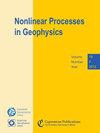Stability and uncertainty assessment of geoelectrical resistivity model parameters: a new hybrid metaheuristic algorithm and posterior probability density function approach
IF 2.4
4区 地球科学
Q3 GEOSCIENCES, MULTIDISCIPLINARY
引用次数: 0
Abstract
Abstract. Estimating a reliable subsurface resistivity structure using conventional techniques is challenging due to the nonlinear nature of the inverse problems. The performance of the inversion techniques can be pretty ambiguous based on the optimal error, although traditional methods have proven to be quite effective. In this work, the impacts of the constraints accessible from a borehole are examined for further assessment and to enhance algorithm effectivity. The vPSOGWO strategy is a new approach that is based on a model search space without any prior information, and it describes the hybridization of particle swarm optimization (PSO) with the Grey Wolf Optimizer (GWO). To understand the efficiency and novelty of the algorithm, it has been validated on two different kinds of synthetic resistivity data with various sets of noise and, subsequently, applied to three field datasets of different geological terrains. The analyzed results suggest that the subsurface resistivity model shows considerable uncertainty. Thus, it is superior to examine the histograms and posterior probability density functions (PDFs) of such solutions to exemplify the global solution. A PDF with a 68.27 % confidence interval (CI) selects a region with a higher probability. Therefore, the inverted models are used to estimate the mean global solution and the most negligible uncertainties, where the mean global solution represents the best solution. Our vPSOGWO-inverted outcomes have been proven to be more accurate than classic PSO, GWO, and state-of-the-art variants of classic approaches. As a result, this novel method plays a vital role in vertical electrical sounding (VES) data inversion.地质电阻率模型参数的稳定性和不确定性评估:一种新的混合元启发式算法和后验概率密度函数方法
摘要由于反演问题的非线性性质,使用传统技术估算可靠的地下电阻率结构具有挑战性。尽管传统方法已被证明相当有效,但根据最佳误差,反演技术的性能可能相当模糊。在这项工作中,为了进一步评估和提高算法的有效性,研究了可从钻孔获得的约束条件的影响。vPSOGWO 策略是一种基于模型搜索空间的新方法,不需要任何先验信息,它描述了粒子群优化(PSO)与灰狼优化器(GWO)的混合。为了解该算法的效率和新颖性,我们在两种不同类型的合成电阻率数据上对其进行了验证,并将其应用于三种不同地质地形的野外数据集。分析结果表明,地下电阻率模型具有相当大的不确定性。因此,研究此类解法的直方图和后验概率密度函数(PDF)来示范全局解法是更有优势的。具有 68.27% 置信区间 (CI) 的后验概率密度函数选择了一个概率较高的区域。因此,反演模型用于估算平均全局解决方案和最可忽略的不确定性,其中平均全局解决方案代表最佳解决方案。事实证明,我们的 vPSOGWO 反演结果比经典 PSO、GWO 和经典方法的最新变体更准确。因此,这种新方法在垂直电探测(VES)数据反演中发挥了重要作用。
本文章由计算机程序翻译,如有差异,请以英文原文为准。
求助全文
约1分钟内获得全文
求助全文
来源期刊

Nonlinear Processes in Geophysics
地学-地球化学与地球物理
CiteScore
4.00
自引率
0.00%
发文量
21
审稿时长
6-12 weeks
期刊介绍:
Nonlinear Processes in Geophysics (NPG) is an international, inter-/trans-disciplinary, non-profit journal devoted to breaking the deadlocks often faced by standard approaches in Earth and space sciences. It therefore solicits disruptive and innovative concepts and methodologies, as well as original applications of these to address the ubiquitous complexity in geoscience systems, and in interacting social and biological systems. Such systems are nonlinear, with responses strongly non-proportional to perturbations, and show an associated extreme variability across scales.
 求助内容:
求助内容: 应助结果提醒方式:
应助结果提醒方式:


